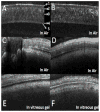Sapphire ball lens-based fiber probe for common-path optical coherence tomography and its applications in corneal and retinal imaging
- PMID: 23202062
- PMCID: PMC3534782
- DOI: 10.1364/OL.37.004835
Sapphire ball lens-based fiber probe for common-path optical coherence tomography and its applications in corneal and retinal imaging
Abstract
We describe a common-path swept source optical coherence tomography fiber probe design using a sapphire ball lens for cross-sectional imaging and sensing for retina vitrectomy surgery. The high refractive index (n=1.75) of the sapphire ball lens improves the focusing power and enables the probe to operate in the intraocular space. The highly precise spherical shape of the sapphire lens also reduces astigmatism and coma compared to fused nonspherical ball lenses. A theoretical sensitivity model for common-path optical coherence tomography (CP-OCT) was developed to assess its optimal performance based on an unbalanced photodetector configuration. Two probe designs-with working distances 415 and 1221 μm and lateral resolution 11 and 18 μm-were implemented with sensitivity up to 88 dB, which is significantly higher than previously reported CP-OCT probes. We assessed the performances of the fiber probes by cross-sectional imaging a bovine cornea and retina in air and in vitreous gel with a 1310 nm swept source OCT system. To the best of our knowledge, this is the first demonstration of sapphire ball lens-based CP-OCT probes directly inserted into the vitreous gel of a bovine eyeball for ocular imaging with a sensitivity approaching the theoretical limitation of CP-OCT.
Figures



Similar articles
-
Sapphire ball lensed fiber probe for common-path optical coherence tomography in ocular imaging and sensing.Proc SPIE Int Soc Opt Eng. 2013 Mar 26;8567:10.1117/12.2005099. doi: 10.1117/12.2005099. Proc SPIE Int Soc Opt Eng. 2013. PMID: 24392202 Free PMC article.
-
Astigmatism corrected common path probe for optical coherence tomography.Lasers Surg Med. 2017 Mar;49(3):312-318. doi: 10.1002/lsm.22554. Epub 2016 Aug 4. Lasers Surg Med. 2017. PMID: 27490964
-
Lens-free endoscopy probe for optical coherence tomography.Opt Lett. 2013 Jun 15;38(12):2014-6. doi: 10.1364/OL.38.002014. Opt Lett. 2013. PMID: 23938961 Free PMC article.
-
Retinal applications of swept source optical coherence tomography (OCT) and optical coherence tomography angiography (OCTA).Prog Retin Eye Res. 2021 Sep;84:100951. doi: 10.1016/j.preteyeres.2021.100951. Epub 2021 Jan 28. Prog Retin Eye Res. 2021. PMID: 33516833 Review.
-
Optical coherence tomography and scleral contact lenses: clinical and research applications.Clin Exp Optom. 2019 May;102(3):224-241. doi: 10.1111/cxo.12814. Epub 2018 Jul 30. Clin Exp Optom. 2019. PMID: 30062745 Review.
Cited by
-
Ultrathin lensed fiber-optic probe for optical coherence tomography.Biomed Opt Express. 2016 May 10;7(6):2154-62. doi: 10.1364/BOE.7.002154. eCollection 2016 Jun 1. Biomed Opt Express. 2016. PMID: 27375934 Free PMC article.
-
Optimized light delivery probe using ball lenses for co-registered photoacoustic and ultrasound endo-cavity subsurface imaging.Photoacoustics. 2018 Dec 7;13:66-75. doi: 10.1016/j.pacs.2018.12.001. eCollection 2019 Mar. Photoacoustics. 2018. PMID: 30761264 Free PMC article.
-
Quantitative optical coherence elastography based on fiber-optic probe for in situ measurement of tissue mechanical properties.Biomed Opt Express. 2016 Jan 26;7(2):688-700. doi: 10.1364/BOE.7.000688. eCollection 2016 Feb 1. Biomed Opt Express. 2016. PMID: 26977372 Free PMC article.
-
Ghost reduction in CP-SSOCT having multiple references using Fourier-domain Shift and Sum.IEEE Photonics Technol Lett. 2016 Sep 15;28(18):1972-1975. doi: 10.1109/LPT.2016.2580588. Epub 2016 Jun 14. IEEE Photonics Technol Lett. 2016. PMID: 28042225 Free PMC article.
-
Sapphire ball lensed fiber probe for common-path optical coherence tomography in ocular imaging and sensing.Proc SPIE Int Soc Opt Eng. 2013 Mar 26;8567:10.1117/12.2005099. doi: 10.1117/12.2005099. Proc SPIE Int Soc Opt Eng. 2013. PMID: 24392202 Free PMC article.
References
-
- Fercher AF, Hitzenberger CK, Kamp G, El-Zaiat SY. Measurement of intraocular distances by backscattering spectral interferometry. Opt Commun. 1995;17:6.
-
- Tearney GJ, Brezinski ME, Bouma BE, Boppart SA, Pitris C, Southern JF, Fujimoto JG. In vivo endoscopic optical biopsy with optical coherence tomography. Science. 1997;276:3. - PubMed
-
- Yamanari M, Makita S, Madjarova VD, Yatagai T, Yasuno Y. Fiber-based polarization-sensitive Fourier domain optical coherence tomography using B-scan-oriented polarization modulation method. Opt Express. 2006;14:6502. - PubMed
Publication types
MeSH terms
Grants and funding
LinkOut - more resources
Full Text Sources
Other Literature Sources
Miscellaneous

